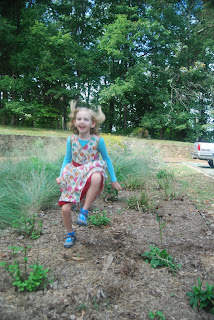I found some lovely floral fabric at my local
fabric store that I couldn't resist. So, I bought a couple of yards for me and my daughter. It sat for a while in my studio until I finally got around to sewing it together earlier in the fall. I had seen a lovely dress in a local store that I love to look in, but rarely buy from. They have lovely children's clothes imported from Europe. They sell the kind of dresses that little girls should wear, you know what I am talking about, cotton dresses with style, no sparkle, no "justin bieber" labels, ... however, they are usually in the $100 plus price range, a little too pricey for me. So, I look around for inspiration and file it away. This is a dress inspired by one that I wanted to buy....
First, I started with a pattern that I have used multiple times,
Burda 3023, but apparently this pattern is no longer in print. I have been using this pattern for my 8 eight year old for years. It still works because of the amount of ease. Anyway, I started with this bodice pattern, then I extended the pattern diagonally to create an overlap in the front, rather like a kimono.

I finished cutting out the two fronts, the two back pieces, and the three skirt pieces (one in front and two in the back to allow for a zipper) out of the floral fabric and lining fabric. Next, I sewed the shoulder seams together on the top and on the lining top.
I placed the lining with the shoulder seams together, so that the lining would have no seams showing inside the dress.

Next, I cut my own binding from a contrasting quilting fabric. I sewed the binding to the neckline of both the left and right fronts with the inner lining in place, and then trimmed the excess.

Next, I turned the binding to the back, pressed it in place, and then sewed "in the ditch" to attach the binding at the back edge free for zipper installation.

At this point I did a fitting with my daughter. She is tall and slim and often the patterns are too large for her frame. As I suspected, the top was overly large. I had her try the top on with a t-shirt, and then pinned it together noting where I needed to trim the top to fit. I also marked the overlap point for the front pieces. I cut the excess fabric from the top side seams from the floral fabric and the lining, and sewed the side seams together. Again, I sewed the dress and lining seams separately making sure that when in place the dress and lining seams were together, so that the lining seam would not show inside the dress.
Next, I took the front and back skirt pieces and gathered them to fit the the top and set them aside.
Now I was ready to make my obi. I cut out four back pieces and two front pieces so that I had two obis, one for the dress and one for lining.
Now, taking my obi pieces, I sewed them together so that the two back pieces were stitched to the front pieces.
I sewed the dress obi to the top, and then sewed the gathered skirt pieces to the obi piece. Then, I sewed an invisible zipper into the back.
Above I said I left the last bit of seam on the binding free for zipper installation, now I will sew it closed. I folded the binding over to catch the zipper, then sewed in the ditch to secure. As you can see below in the second photo, the job I did was not so lovely. If it were a dress for me, I might try and make it look much better. However, my daughter will out grow this dress in a year or less, so in lieu of spending more time, I moved on.


I then put interfacing in place inside the dress to reinforce the obi.
Next, I attached the skirt lining, which I had cut in an A-line shape to the obi that would be in the lining. I folded the top of the inner obi in place and pressed it down. Finally, I carefully pinned the inner obi in place over the interfacing and stitched in the ditch to attach the obi lining to the dress.
A second detail that is still not beautiful about the inside is that the zipper shows. I didn't do anything to hide it in the inside of the dress.
Next, I wanted to bind the sleeves. With the same binding that I used for the front neck pieces, I bound the sleeve edges.
Here is a photo of what the inside of the dress looks like at this point.
As a finishing touch, I decided to encase the bottom of the dress in a 2 inch hem casing of the same fabric as the obi. I also serged the lining hem. Finally the dress was ready for wearing. My ballerina was thrilled. Here she is on an early fall afternoon in our garden wearing the dress I should have finished earlier in the summer practicing her pas de chat and arabesque.































